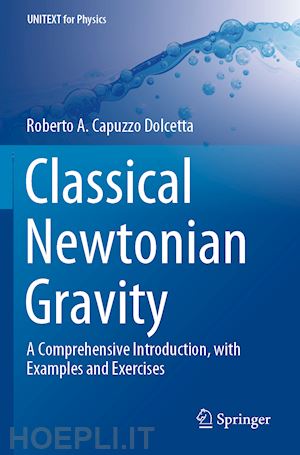
Questo prodotto usufruisce delle SPEDIZIONI GRATIS
selezionando l'opzione Corriere Veloce in fase di ordine.
Pagabile anche con Carta della cultura giovani e del merito, 18App Bonus Cultura e Carta del Docente
This textbook offers a readily comprehensible introduction to classical Newtonian gravitation, which is fundamental for an understanding of classical mechanics and is particularly relevant to Astrophysics. The opening chapter recalls essential elements of vectorial calculus, especially to provide the formalism used in subsequent chapters. In chapter two Classical Newtonian gravity theory for one point mass and for a generic number N of point masses is then presented and discussed. The theory for point masses is naturally extended to the continuous case. The third chapter addresses the paradigmatic case of spherical symmetry in the mass density distribution (central force), with introduction of the useful tool of qualitative treatment of motion. Subsequent chapters discuss the general case of non-symmetric mass density distribution and develop classical potential theory, with elements of harmonic theory, which is essential to understand the potential development in series of the gravitational potential, the subject of the fourth chapter. Finally, in the last chapter the specific case of motion of a satellite around the earth is considered. Examples and exercises are presented throughout the book to clarify aspects of the theory.
The book is aimed at those who wish to progress further beyond an initial bachelor degree, onward to a master degree, and a PhD. It is also a valuable resource for postgraduates and active researchers in the field.
Roberto A. Capuzzo-Dolcetta worked for 20 years as a full-time researcher at the University of Roma La Sapienza, until, in July 2000, he became Associate Professor in Astronomy and Astrophysics, where he is now teaching Fluid dynamics for Astrophysics and Theoretical Astrophysics. He has also a long term experience in teaching Gravitational Physics and Theoretical Mechanics at both undergraduate and graduate level. He has also been teaching in the United States, delivering, for instance, the undergraduate course on Extragalactic Astronomy and Cosmology at the University of Washington and Seattle and presenting lectures for graduate students at Boston University. Since May 2010 he has been a scientific reviewer for ISCRA (Italian Super Computing Research Allocation) at CINECA and leader of the panel of Universe Science of the Access Committee of PRACE (the european infrastructure for super computing). His research activity is mainly theoretical, in the field of stellar clusters, both galactic and extragalactic. He is an expert in sophisticated numerical methods to deal with large self-gravitating N-body systems. He has obtained important results concerning the evolution and dynamics of the globular cluster systems in galaxies, and proposed a new original explanation for mass accretion and activity of galactic nuclei. He is the author of more than 200 scientific papers in international journals.











Il sito utilizza cookie ed altri strumenti di tracciamento che raccolgono informazioni dal dispositivo dell’utente. Oltre ai cookie tecnici ed analitici aggregati, strettamente necessari per il funzionamento di questo sito web, previo consenso dell’utente possono essere installati cookie di profilazione e marketing e cookie dei social media. Cliccando su “Accetto tutti i cookie” saranno attivate tutte le categorie di cookie. Per accettare solo deterninate categorie di cookie, cliccare invece su “Impostazioni cookie”. Chiudendo il banner o continuando a navigare saranno installati solo cookie tecnici. Per maggiori dettagli, consultare la Cookie Policy.